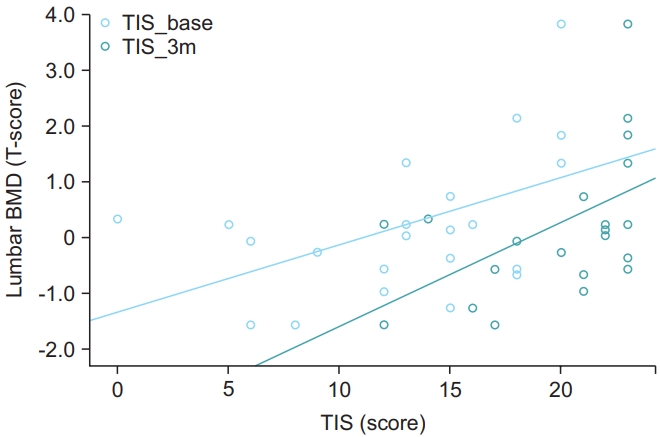- Search
| Ann Rehabil Med > Volume 47(2); 2023 > Article |
|
Abstract
Objective
Methods
Results
Conclusion
AUTHOR CONTRIBUTION
Conceptualization: Cho YH, Kim HJ. Methodology: Cho YH, Lee SY, Kim HJ. Formal analysis: Cho YH, Kim HJ. Funding acquisition: Kim HJ. Project administration: Cho YH, Seok H, Kim SH, Lee SY, Kim HJ. Visualization: Cho YH. Writing – original draft: Cho YH. Writing – review and editing: Cho YH, Seok H, Kim SH, Lee SY, Kim HJ. Approval of final manuscript: all authors.
Fig. 1.

Fig. 2.

Table 1.
Table 2.
Table 3.
|
Femur neck (paretic) |
Total proximal femur (paretic) |
Femur neck (nonparetic) |
Total proximal femur (nonparetic) |
Lumbar vertebrae |
||||||
|---|---|---|---|---|---|---|---|---|---|---|
| r | p-value | r | p-value | r | p-value | r | p-value | r | p-value | |
| BMI | 0.421 | 0.038* | 0.456 | 0.029* | 0.429 | 0.041* | 0.464 | 0.026* | 0.494 | 0.017* |
| TIS_B | 0.220 | 0.313 | 0.379 | 0.075 | 0.206 | 0.347 | 0.248 | 0.222 | 0.522 | 0.011* |
| BBS_B | 0.257 | 0.237 | 0.252 | 0.246 | 0.329 | 0.125 | 0.415 | 0.049* | 0.442 | 0.035* |
| K-MBI_B | 0.163 | 0.457 | 0.215 | 0.323 | 0.184 | 0.400 | 0.074 | 0.736 | 0.245 | 0.260 |
| MMT_B | 0.169 | 0.441 | 0.246 | 0.257 | 0.149 | 0.498 | 0.173 | 0.431 | 0.409 | 0.052 |
| TIS_3m | 0.296 | 0.171 | 0.368 | 0.084 | 0.189 | 0.388 | 0.221 | 0.310 | 0.517 | 0.011* |
| BBS_3m | 0.130 | 0.554 | 0.073 | 0.741 | 0.019 | 0.932 | 0.063 | 0.776 | 0.222 | 0.309 |
| K-MBI_3m | 0.204 | 0.351 | 0.298 | 0.167 | 0.094 | 0.670 | 0.154 | 0.482 | 0.301 | 0.163 |
| MMT_3m | 0.247 | 0.257 | 0.304 | 0.159 | 0.154 | 0.482 | 0.290 | 0.180 | 0.313 | 0.146 |
The data is presented as Pearson correlation coefficients and p-value.
BMI, body mass index; TIS_B, Trunk Impairment Scale at baseline; BBS_B, Berg Balance Scale at baseline; K-MBI_B, Korean version of Modified Barthel Index at baseline; MMT_B, manual muscle test at baseline; TIS_3m, Trunk Impairment Scale at 3 months after stroke; BBS_3m, Berg Balance Scale at 3 months after stroke; K-MBI_3m, Korean version of Modified Barthel Index at 3 months after stroke; MMT_3m, manual muscle test at 3 months after stroke.
Table 4.
|
Univariable |
Multivariable |
|||
|---|---|---|---|---|
| Standardized coefficient β (95% CI) | p-value | Standardized coefficient β (95% CI) | p-value | |
| Age (yr) | -0.400 (-0.099 to 0.083) | 0.856 | - | - |
| Body mass index (kg/m2) | 0.494 (0.047–0.418) | 0.017* | 0.450 (0.033–0.190) | 0.012* |
| Duration from onset to BMD exam (day) | 0.406 (-0.001 to 0.079) | 0.054 | - | - |
| TIS_B | 0.522 (0.031–0.210) | 0.011* | 0.481 (0.052–0.372) | 0.008* |
| BBS_B | 0.442 (0.003–0.068) | 0.035* | - | - |
| K-MBI_B | 0.245 (-0.012 to 0.041) | 0.260 | - | - |
| MMT_B | 0.409 (-0.003 to 0.532) | 0.052 | - | - |
| TIS_3m | 0.517 (0.046–0.325) | 0.011* | - | - |
| BBS_3m | 0.222 (-0.018 to 0.053) | 0.309 | - | - |
| K-MBI_3m | 0.301 (-0.008 to 0.046) | 0.163 | - | - |
| MMT_3m | 0.313 (-0.087 to 0.548) | 0.146 | - | - |
Adjusted R2 for multivariable model is 0.474.
BMD, bone mineral density; CI, confidence interval; TIS_B, Trunk Impairment Scale at baseline; BBS_B, Berg Balance Scale at baseline; K-MBI_B, Korean version of Modified Barthel Index at baseline; MMT_B, manual muscle test at baseline; TIS_3m, Trunk Impairment Scale at 3 months after stroke; BBS_3m, Berg Balance Scale at 3 months after stroke; K-MBI_3m, Korean version of Modified Barthel Index at 3 months after stroke; MMT_3m, manual muscle test at 3 months after stroke.
REFERENCES
- TOOLS
-
METRICS

- Related articles in ARM
-
Trunk Muscle Strength and Bone Mineral Density in Women.1998 December;22(6)
The Bone Mineral Densities in Patients with Hemiplegic Stroke.2003 February;27(1)
The Pre-stroke Bone Mineral Density in First Stroke Patients.2010 June;34(3)
Factors Affecting Bone Mineral Density in Adults with Cerebral Palsy2012 December;36(6)







